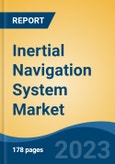Speak directly to the analyst to clarify any post sales queries you may have.
10% Free customizationThis report comes with 10% free customization, enabling you to add data that meets your specific business needs.
An inertial navigation system calculates a moving object's velocity, gravitational force, and directional orientation. Motion sensors, accelerometers, and gyroscopes are all part of an inertial navigation system. All instruments are fitted in aircrafts thus increase in the demand of aircrafts also propel the market of inertial navigation system.
The object's orientation and relative position are calculated using similar derivations. Furthermore, inertial navigation systems are employed in navigation applications and in aircraft where precision and performance are critical. Furthermore, inertial navigation technology enables for the measurement of a vehicle's acceleration using mathematical computations.
An Inertial Navigation System (INS) is a navigation aid that employs a computer in the computation process to manage the starting velocity and location of a moving item regardless of external positions and employs stable platform approaches. The inertial sensors in the system are positioned on a fixed stage and physically separated from the vehicle's rotational motion, allowing the navigation system to coast through short GPS outages with great accuracy.
Rising Defense expenditure among nations
Some of the primary reasons driving the growth of the worldwide inertial navigation system market include an increase in defense spending among emerging nations, an increase in demand for navigation precision, and an increase in demand for aircrafts. However, the operational complexity of inertial navigation systems, as well as the fall in military spending in some key nations, are projected to hinder the growth of the inertial navigation system market. Technological improvements in MEMS-based inertial navigation systems, on the other hand, will be opportune for the growth of the inertial navigation system market.Demand of unmanned vehicle will boost the Inertial Navigation market.
The market for inertial navigation systems is seeing a surge in demand for unmanned vehicles in the military industry. Precision and performance are crucial in aerospace and navigation applications that use inertial navigation systems. Furthermore, inertial navigation technology measures a vehicle's acceleration using mathematical equations. Unmanned systems such as unmanned underwater vehicles (UUVs) and unmanned aerial vehicles (UAVs) can benefit greatly from inertial navigation systems. These are often utilized in the oil and gas and defense industries. UUVs are utilized in the defense industry for port security, underwater mine deactivation, and counterattacking. Inertial Navigation Systems (INS) are used in these unmanned vehicles to offer precise navigation and position data.
Navigational Technological Advancements Market Growth is Driven by the Market
This market is driven by advancements in navigation technology, the growing aerospace industry, and the availability of solid and small components. Furthermore, rising technical breakthroughs in MEMS (micro-electro-mechanical systems) and the use of satellite navigation are two additional reasons that are contributing to the market's expansion. Because of the utilisation of MEMs, manufacturers have created more cost-effective and efficient solutions, resulting in light, compact, and low-cost navigation systems. This is another key factor responsible for the growth of the Inertial Navigation System MarketMarket Segmentation
Global Inertial Navigation System Market is segmented by Technology, Application, Component, and By Vertical. Based on Technology, the market is segmented into Ring Laser Gyro, Mechanical Gyro, Fiber Optics Gyro, MEMS, and Others. Based on Application, the market is segmented into Aircraft, Missiles, Marine, and Unmanned Vehicles. By Component into Accelerometers, Gyroscopes, and Wireless Systems, by Vertical into Commercial, Military & Defense, and Other End-user Industries.Market Players
Major market players in the Global Inertial Navigation System Market are Honeywell International Inc, Northrop Grumman Corporation, Tersus GNSS INC, Raytheon Technologies Corporation, Thales Group, Safran, General Electric Company, IXblue SAS, PARKER-HANNIFIN CORPORATION, Teledyne Technologies Incorporated.Report Scope
In this report, the Global Inertial Navigation System Market has been segmented into the following categories, in addition to the industry trends which have also been detailed below:Inertial Navigation System Market, by Technology:
- Ring Laser Gyro
- Mechanical Gyro
- Fiber Optics Gyro
- MEMS
- Others
Inertial Navigation System Market, by Application:
- Aircraft
- Missiles
- Marine
- Unmanned Vehicles
Inertial Navigation System Market, by Component:
- Accelerometers
- Gyroscopes
- Wireless Systems
Inertial Navigation System Market, by Vertical:
- Commercial
- Military & Defense
- Other End-user Industries
Inertial Navigation System Market, by Region:
- North America
- Asia-Pacific
- Europe
- South America
- Middle East & Africa
Competitive Landscape
Company Profiles: Detailed analysis of the major companies present in the Global Inertial Navigation System Market.Available Customizations
The following customization options are available for the report:- Detailed analysis and profiling of additional market players (up to five).
This product will be delivered within 1-3 business days.
Table of Contents
Companies Mentioned
- Honeywell International Inc.
- Northrop Grumman Corporation
- Tersus GNSS INC
- Raytheon Technologies Corporation
- Thales Group
- Safran
- General Electric Company
- IXblue SAS
- Parker-Hannifin Corporation
- Teledyne Technologies Incorporated
Table Information
| Report Attribute | Details |
|---|---|
| No. of Pages | 178 |
| Published | September 2023 |
| Forecast Period | 2022 - 2028 |
| Estimated Market Value ( USD | $ 11.6 Billion |
| Forecasted Market Value ( USD | $ 16.27 Billion |
| Compound Annual Growth Rate | 5.8% |
| Regions Covered | Global |
| No. of Companies Mentioned | 10 |









